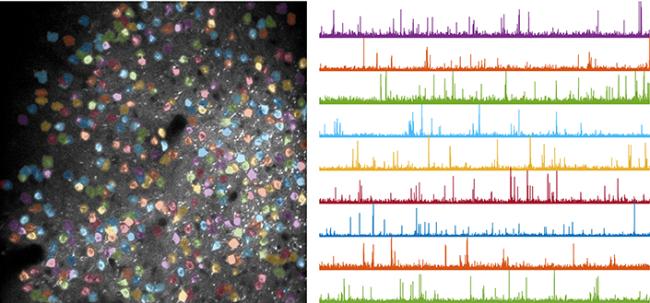Brain circuit rewiring during motor learning
May 20, 2025
Brain circuit rewiring during motor learning
At a Glance
- A new study in mice sheds light on how brain circuits get rewired when learning new movements.
- Although much work still needs to be done, the findings may help point the way to develop improved aids for people with certain movement disorders.

In motor learning, movements become faster and more consistent with repeated practice. The brain’s primary motor cortex (M1) is central to this process. In particular, synapses connecting to the superficial layer of M1 reorganize during motor learning. Neurons in this layer develop reproducible activity that accompanies learned movements. But it hasn’t been known where in the brain the signals driving this activity come from. Nor has it been clear how this pathway changes during motor learning.
A research team led by Drs. Marcus Benna and Takaki Komiyama at the University of California, San Diego sought to answer these questions. To do so, they engineered mice so that neurons connecting to M1 from other brain regions would light up when activated. They trained the mice to push a lever in response to a sound cue and examined neuron activity from these different regions before and after training. Results of the study, which was funded in part by NIH, appeared in Nature on May 7, 2025.
The researchers found that the inputs most associated with the learned movement came from a region called the motor thalamus. The timing of the inputs from the thalamus closely correlated with when the learned movement occurred. In “expert” mice, trained for two weeks, these inputs shifted earlier. This suggests that inputs from the motor thalamus to M1 encode the learned movements.
Next, the scientists further engineered mice so that thalamic neurons that connected to M1 could be turned on by specific wavelengths of light. They also engineered M1 neurons to light up when activated. Using these, the team identified which neurons in the M1 superficial layer were activated by the motor thalamus neurons. They called these activated M1 neurons “Th-excited.”
In expert mice, activity related to the learned movement occurred primarily in Th-excited neurons. In contrast, in untrained mice there was little difference in movement-related activation between Th-excited and non-Th-excited neurons.
The Th-excited neuron population evolved over the course of learning. The motor thalamus began exciting more neurons whose activity was associated with the learned movement. And it stopped exciting neurons that weren’t associated with the movement. In neurons that remained Th-excited throughout learning, activity became more closely associated with the learned movement.
Inactivating motor thalamus neurons in expert mice significantly impaired the mice’s ability to perform the learned movement. This confirmed that the precise execution of learned movements requires input from the motor thalamus.
Taken together, these results shed light on changes in the brain that occur during motor learning. In effect, the motor thalamus learns to activate the right neurons and stop activating the wrong ones. This enables rapid and consistent performance of the learned movement.
“The study shows that learning isn’t just repetition,” says lead author Dr. Assaf Ramot. “It’s about your brain literally rewiring itself in a targeted way. Whether you’re learning a new skill, recovering from a stroke or using a neuroprosthetic, understanding how brain regions reorganize their communication helps us design better therapies and technologies that work with the brain’s natural learning mechanisms.”
—by Brian Doctrow, Ph.D.
Related Links
- Research in Context: Movement After Paralysis
- Stroke Patients May Benefit from Brain Stimulation
- New Insights into the Brain’s Motor Cortex
- Mapping the Mammalian Motor Cortex
- New Role Discovered for the Thalamus
- Brain Basics: Know Your Brain
- The Amazing Brain: Where Thoughts Trigger Body Movement
References
Motor learning refines thalamic influence on motor cortex. Ramot A, Taschbach FH, Yang YC, Hu Y, Chen Q, Morales BC, Wang XC, Wu A, Tye KM, Benna MK, Komiyama T. Nature. 2025 May 7. doi: 10.1038/s41586-025-08962-8. Online ahead of print. PMID: 40335698.
Funding
NIH’s National Institute of Neurological Disorders and Stroke (NINDS), National Institute on Deafness and Other Communication Disorders (NIDCD), and National Institute of Mental Health (NIMH); National Science Foundation; Simons Foundation.


